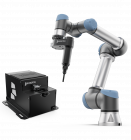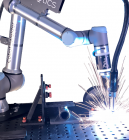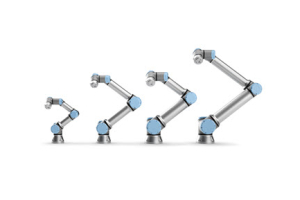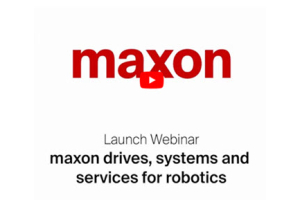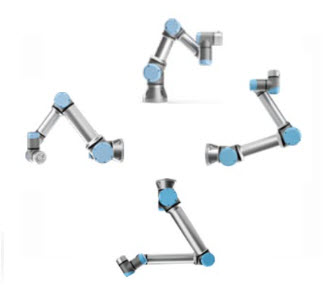
Cobots, or collaborative robots, are a relatively new technology in the industrial automation space, but they have already made a significant impact on the manufacturing and production industries. The concept of cobots was first introduced in the late 1990s, but it wasn’t until the early 2010s that the technology started to become widely adopted.
Today, cobots are an essential tool for companies looking to improve efficiency, increase productivity, and reduce costs. In this article, we explore the history of cobots and the components that go into making a cobot.


The concept of cobots is based on the idea of creating robots that can work alongside human workers in a collaborative environment. This differs from traditional industrial robots, which are often isolated from human workers and operate in separate, designated areas. Cobots were designed with safety in mind, with features that allow them to stop or reduce their movements if they come into contact with a human worker. This makes them ideal for use in environments where human workers are present, such as on factory floors or in production areas.
The key components that make up a cobot include a controller, sensors, actuators, and a control system.
- The controller is the “brain” of the cobot and is responsible for processing data from the sensors and determining the best actions for the cobot to take.
- Sensors are used to detect the presence of humans and other objects, allowing the cobot to respond appropriately.
- Actuators are responsible for controlling the movement of the cobot and allowing it to perform various tasks.
- The control system is the software that ties everything together, allowing the cobot to communicate with the controller and perform its designated tasks.
One of the key benefits of cobots is their ability to automate repetitive tasks, freeing up human workers to focus on more complex tasks. This can lead to increased efficiency and productivity, as well as reducing the risk of repetitive strain injuries and other workplace hazards. Cobots can also be programmed to perform tasks that are too dangerous or difficult for human workers, such as working in hazardous environments or handling heavy loads.
Here is a brief timeline of the history of cobots:
- Late 1990s: The concept of cobots is introduced by Dr. Esben Østergaard, a Danish engineer who developed the first cobot, the UR5, while working on his PhD.
- 2008: Universal Robots is founded in Denmark and begins selling the UR5 cobot.
- 2010: The first ISO standard for cobots is published, providing guidelines for safe collaborative operation with humans.
- 2012: Rethink Robotics is founded in the United States and introduces the Baxter cobot, which is designed to work in a variety of manufacturing environments.
- 2014: ABB introduces the YuMi cobot, which is designed to work alongside human workers in small parts assembly and other delicate tasks.
- 2015: KUKA introduces the LBR iiwa cobot, which is designed to work in a variety of industries, including automotive, aerospace, and medical.
- 2017: The global market for cobots reaches $200 million.
- 2018: The global market for cobots reaches $500 million.
- 2021: The global market for cobots is expected to reach $8 billion by 2030.
As the technology has advanced, more companies have entered the cobot market, including Fanuc, Epson, and Doosan Robotics. With the continued growth and development of cobots, they are expected to play an increasingly important role in the future of manufacturing and production.
The number of industries/applications that cobots have been introduced to have also rapidly grown in recent years.
Some of the industries where cobots have become particularly common include:
- Manufacturing: Cobots are widely used in manufacturing for tasks such as assembly, packaging, and inspection. They can work alongside human workers to increase efficiency and productivity, and they can also perform tasks that are too dangerous or difficult for humans.
- Automotive: Cobots are commonly used in automotive manufacturing for tasks such as welding, painting, and assembly. They are particularly useful for tasks that require precision and repeatability.
- Food and Beverage: Cobots are increasingly being used in the food and beverage industry for tasks such as packaging, labeling, and quality control. They are particularly useful in environments where hygiene is critical, as they can be easily cleaned and sanitized.
- Healthcare: Cobots are being used in healthcare for tasks such as dispensing medication, moving patients, and cleaning facilities. They can help reduce the risk of infection and injury to both patients and healthcare workers.
- Logistics and Warehousing: Cobots are being used in logistics and warehousing for tasks such as picking, packing, and sorting. They can work alongside human workers to increase efficiency and productivity, and they can also help reduce the risk of injury from repetitive tasks.
Overall, cobots have become increasingly common in industries where there is a need for automation, increased efficiency, and improved safety. With their ability to work alongside human workers, cobots offer a new level of collaboration and flexibility in the workplace.
Cobots have come a long way since their introduction in the late 1990s, and the technology continues to evolve and improve. Today, there are a wide range of cobots available, from simple, single-axis robots to more advanced, multi-axis robots with sophisticated control systems. These advanced cobots can perform complex tasks and interact with human workers in real-time, making them a valuable asset to any manufacturing or production environment. Cobots have revolutionized the manufacturing and production industries, offering a new level of automation and efficiency. With their ability to work alongside human workers and automate repetitive tasks, cobots are a valuable tool for companies looking to improve their operations and stay ahead of the competition.




